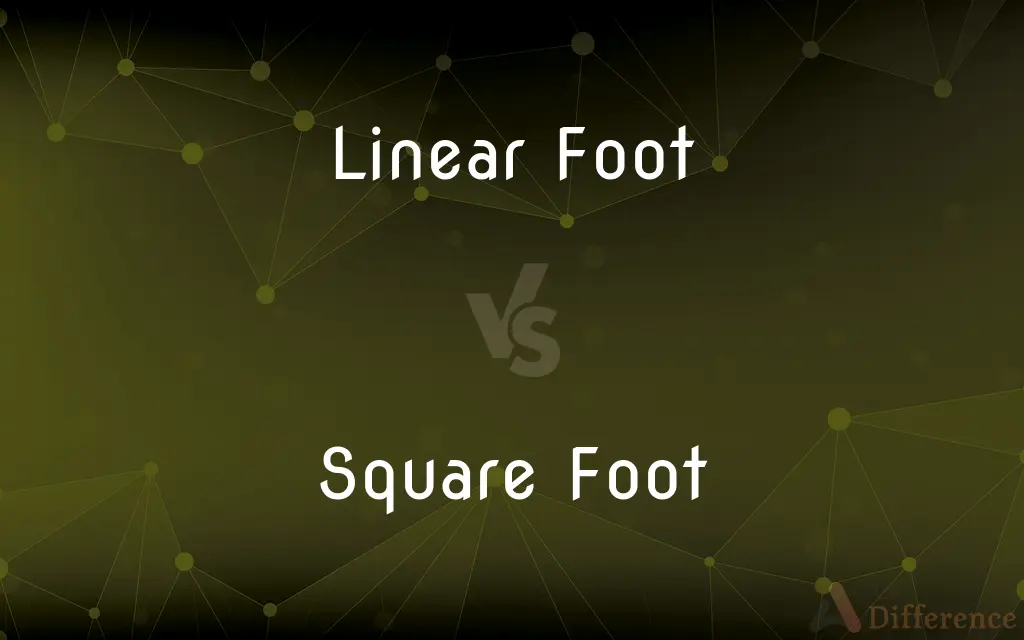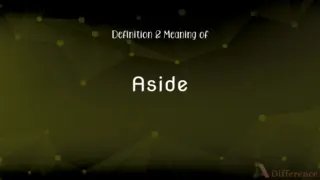Linear Foot vs. Square Foot — What's the Difference?
By Tayyaba Rehman — Published on November 28, 2023
A Linear Foot measures length in one direction, while a Square Foot measures area in two dimensions. Example: A board 5 feet long is 5 linear feet, while a 5x5 foot area is 25 square feet.

Difference Between Linear Foot and Square Foot
Table of Contents
ADVERTISEMENT
Key Differences
A Linear Foot pertains to the measurement of length in one dimension. When one speaks about Linear Foot, it generally refers to the length of a given item without considering its width or height. On the other hand, Square Foot refers to a measurement of area, which is a two-dimensional concept.
In the construction and carpentry industries, the term Linear Foot is commonly used when referring to materials like lumber, pipes, or wires. For example, a piece of lumber that is 10 feet long would be described as being 10 linear feet. Square Foot, on the other hand, is commonly used in real estate and interior design. It measures the total area of a space.
When buying materials, it's crucial to know the distinction. If you're purchasing flooring, for example, you'd need to know the total Square Footage of your room. But if you were buying baseboards, the Linear Foot measurement would be more appropriate. Square Foot indicates how much space an area covers, while Linear Foot indicates how long something is.
Suppose you had a rectangular garden bed that was 5 feet in length and 3 feet in width. It would span 5 Linear Feet along its longest edge. However, its total area would be 15 Square Feet. The distinction between these terms is fundamental in various fields, ensuring accurate measurements and calculations.
Comparison Chart
Dimension
One-dimensional (length)
Two-dimensional (length x width)
ADVERTISEMENT
Unit of
Length
Area
Common Usage
Materials like lumber, pipes, wires
Floor area, real estate, room sizes
Measurement Tool
Tape measure (length only)
Tape measure (length x width) or area calculator
Example
A board 10 feet long is 10 linear feet
A room 10 feet by 10 feet is 100 square feet
Compare with Definitions
Linear Foot
The distance from one end to another of an object.
The pipe spans 15 Linear Feet from the house to the street.
Square Foot
A standard measure for floor area or land.
The office has a usable space of 2,000 Square Feet.
Linear Foot
The length of an item irrespective of its width or height.
The carpet roll has a breadth of 12 Linear Feet, perfect for the hallway.
Square Foot
The amount of surface covered by a square measuring one foot by one foot.
She bought tiles for a space of 50 Square Feet.
Linear Foot
A unit of measurement representing one foot in length.
The rope is sold by the Linear Foot, so a 10-foot piece costs ten times the per-foot price.
Square Foot
The product of the length and width of a rectangular space.
A room that's 10 feet wide and 10 feet long is 100 Square Feet.
Linear Foot
A one-dimensional measurement of length.
The fence stretches for 50 Linear Feet along the property line.
Square Foot
A unit of area representing a square with sides of one foot in length.
The tiny apartment was only 300 Square Feet in total.
Linear Foot
A straight-line measurement of 12 inches.
For the shelving, we will need 20 Linear Feet of wood.
Square Foot
A two-dimensional measurement of space.
The garden covers an area of 100 Square Feet.
Common Curiosities
What's represented by a Square Foot?
A Square Foot represents a unit of area measuring one foot by one foot.
When would I use Linear Foot as a measurement?
You'd use Linear Foot when measuring the length of items like lumber, pipes, or wires.
In which scenarios is Square Foot typically used?
Square Foot is used when referring to the area of a space, such as in real estate or room sizes.
What does Linear Foot measure?
A Linear Foot measures the length of an item in one direction.
Can 10 Linear Feet be equal to 10 Square Feet?
No, they represent different concepts: length vs. area.
Why is it important to distinguish between Linear Foot and Square Foot?
The distinction ensures accurate calculations and measurements, especially in construction and real estate.
Can a space be 10 Linear Feet long but have more than 10 Square Feet of area?
Yes, if a space is 10 Linear Feet long and more than 1 foot wide, it will have an area greater than 10 Square Feet.
Are both Linear Foot and Square Foot standardized measurements?
Yes, both are standardized measurements in the American system.
How do I convert Square Feet into Linear Feet?
You can't directly convert them as they measure different things: one measures length and the other measures area.
How many Square Feet are in a room that's 5 Linear Feet by 7 Linear Feet?
The room would be 35 Square Feet.
If I have a plot of 100 Square Feet, what's its length in Linear Feet?
You can't determine the length in Linear Feet based on Square Footage alone, as it depends on the plot's shape and dimensions.
How do I measure the Linear Feet of a circular object?
You'd measure its circumference to determine the Linear Feet.
Are Linear Foot and Square Foot used internationally?
While they are standard in the US, other countries might use meters for similar measurements.
Is the price of flooring typically quoted in Linear Feet or Square Feet?
Flooring is usually quoted in Square Feet since it's about covering area.
Is the width of an object considered when measuring Linear Feet?
No, Linear Foot only considers length.
Share Your Discovery

Previous Comparison
Alkyl Halide vs. Aryl Halide
Next Comparison
Kung Fu vs. TaekwondoAuthor Spotlight
Written by
Tayyaba RehmanTayyaba Rehman is a distinguished writer, currently serving as a primary contributor to askdifference.com. As a researcher in semantics and etymology, Tayyaba's passion for the complexity of languages and their distinctions has found a perfect home on the platform. Tayyaba delves into the intricacies of language, distinguishing between commonly confused words and phrases, thereby providing clarity for readers worldwide.
















































